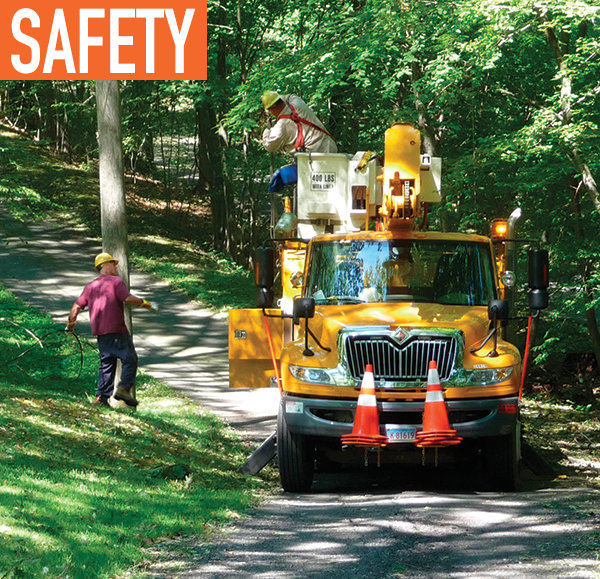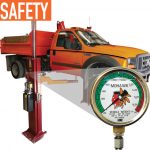Whether your utility work involves power, telecom, or CATV, aerial devices—particularly bucket trucks—are some of the most important machines in your equipment fleet. To maintain safe productivity on any jobsite, follow these best practices for safe set up, operation, and care for your bucket truck.
SET UP
Before any work begins, says Jim Olson, product and safety engineer, Terex Utilities, you need to conduct a site survey—identify potential hazards that you need to avoid during operation, including ditches, drop-offs, holes, debris, sewers, overhead obstructions, electrical conductors, and underground utilities.
“Because we do a lot of new installation work in wetlands and sensitive environments, we send right-of-way agents and surveyors out to the project site prior to job startup to determine if we need any special permits from the DNR or wildlife organizations to work in the area,” says Garry Christopherson, director, safety and security, Dairyland Power Cooperative, La Crosse, Wisconsin. “We then work with these groups to insure our site setup is safe for our crew and equipment, as well as for the environment.”
At this point, says Olson, you also need to determine if the ground is firm enough to support your bucket truck. If the ground is not firm enough, you need to use pads under the outriggers and crib as needed to distribute the load or reposition the truck on firm ground. If your bucket truck does not have outriggers or is only equipped with one set, make sure all the tires and axle suspension springs are equally loaded.
“Always set up your truck in a position to safely do the work,” advises Olson.
“Because of the environments we’re working in,” continues Christopherson, “we often need to put down special matting to park our trucks on. We may also need to create a road or special access point in and out of the site for our trucks to travel on, as well as put up fencing or other barricades to make sure we protect site conditions.”

Featured Image: Before any work begins, you should conduct a site survey to identify potential hazards you need to avoid during operation, including ditches, drop-offs, holes, debris, sewers, overhead obstructions, electrical conductors, and underground utilities.
Above: Make sure your crew is properly equipped for the project; operators must wear an OSHA compliant fall protection system with a lanyard attached to the aerial device anchorage at all times.
If you must park the vehicle on a slope, always keep the boom on the uphill side, chock the wheels, and work off the rear of the truck. Per ANSI A92.2, bucket trucks should be operated on firm, flat surfaces and never exceed a 5-degree slope. “Use your bucket truck’s chassis level indicator to make sure the truck is always set within the manufacturers operational limits,” says Olson. “Terex® utility trucks are equipped with a visual slope indicator that is used to determine that the truck is positioned within a safe incline.”
“You also need to know what the maximum bucket load capacity is on your truck and do not exceed it at any point during operation,” continues Olson. “That means, you need to know how much each person, tool, and accessory weighs before getting into the bucket. And, you need to anticipate how much weight could be added during operation from jobsite materials that accumulate during work.”
It is important to evaluate the site’s ambient conditions, including temperature. Operating in extreme weather conditions requires taking extra precautions to protect your assets.
DAILY BRIEFING BENFITS
A job briefing session is a good way to keep crews informed of the conditions of the jobsite and expectations for the project. These sessions not only include information, such as identification of potential hazards discovered during the site survey, says Olson, but also a discussion about what is required by the truck and the crew to avoid these potential hazards. Every member of your on-site crew should know the location, function, and operation of all the controls, including emergency and accessory operation.
“Once our site survey is done, the crew leader holds a job briefing to discuss all of the elements of the project,” says Christopherson. “These meetings are held every day we’re on-site and every crew member must attend. It is important that each and every team member understands what needs to be accomplished and what challenges are involved.”
DON’T SKIP THE INSPECTION
In addition to a jobsite briefing, you and your crew also need to conduct a visual inspection of the truck—oil, fuel, tires, suspension, torsion bars, outriggers, safety equipment—for any leaks, loose items, cracks, or damage before work begins. This should include raising and lowering the booms through a complete cycle using the lower controls and looking for any malfunction or problems. “When multiple operators use the same truck, no one operator can assume that s/he knows exactly the condition the truck was left in by the previous user, which further emphasizes the need for pre-flight visual inspection and cycling,” says Olson.
“You should never operate a bucket truck that is damaged or malfunctioning,” concludes Olson.
Once your truck is ready to work, it’s important to make sure your crew is properly equipped for the project. “Operators must wear an OSHA compliant fall protection system with a lanyard attached to the aerial device anchorage at all times in case they are ejected from the bucket during work,” says Olson.
“Also, you must make sure crew members are wearing personal protective gear, including an insulated hard hat, hearing and eye protection, proper boots, and suitable clothing for the weather conditions while working,” finishes Olson.
Now that your crew is ready, it is time to prepare the site for operation—follow established protocol for traffic control, setting up road cones or barricades and signs to divert traffic away from the work area. “It is the crew’s responsibility to know and implement proper set up procedures once the site conditions have been assessed,” says Christopherson.
Understanding the big picture of how the task, locale, equipment, and people must interact safely and efficiently on the worksite is one of the biggest challenges on any utility project, because there are multiple variables that crews must assess and manage.

ABOUT THE AUTHOR:
Amber Reed is president of Signature Style PR + Marketing, a PR and content marketing firm. Find out more about Ms. Reed, visit www.signaturestylepr.com.
_______________________________________________________________________
MODERN WORKTRUCK SOLUTIONS: MARCH 2016 ISSUE
Did you enjoy this article?
Subscribe to the FREE Digital Edition of Modern WorkTruck Solutions magazine.
![]()




